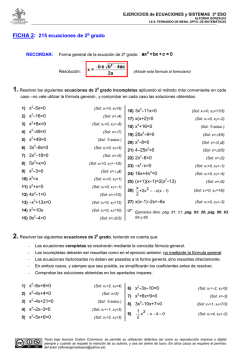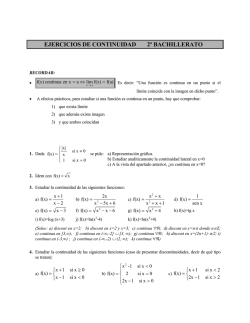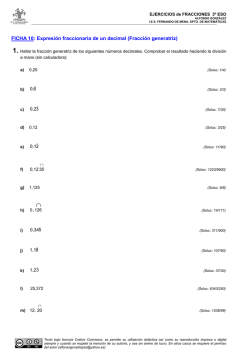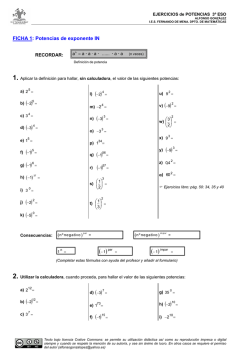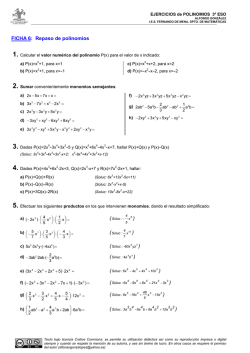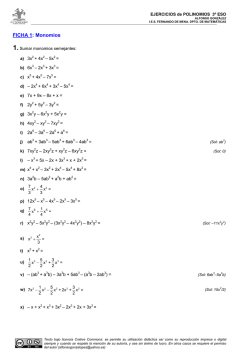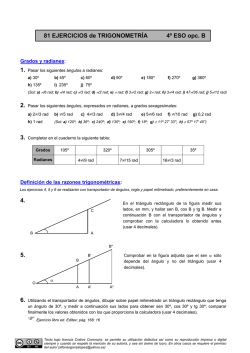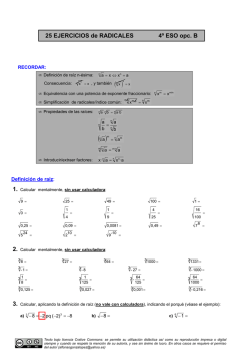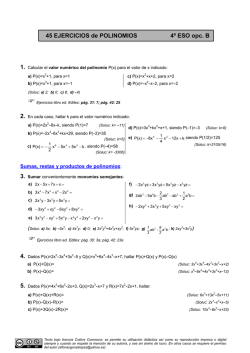
S_A_G_ARPA mm ?SENASICA
EJERCICIOS de ECUACIONES y SISTEMAS 3º ESO ALFONSO GONZÁLEZ I.E.S. FERNANDO DE MENA. DPTO. DE MATEMÁTICAS FICHA 1: 182 ecuaciones de 1er grado 1. Resolver las siguientes ecuaciones de 1er grado elementales, y comprobar (mentalmente) cada solución obtenida (en caso de ser una identidad, o carecer de solución, indicarlo): 1) x−2=3 (Sol: x=5) (Sol: x=0) x+2=3 30) − 7x = 0 2) (Sol: x=1) (Sol: x=1) x − 3 = −1 31) 2 = 4 − 2x 3) (Sol: x=2) 32) 2 − 12x = 0 4) x + 1 = −2 (Sol: x=-3) 5) x−5=0 (Sol: x=5) 6) 2 = x + 5 (Sol: x=-3) 7) 3 − x = 2 (Sol: x=1) 8) x+5=0 (Sol: x=-5) 9) 4 = 1− x (Sol: x=-3) 10) x + 3 = 3 (Sol: x=0) 11) − x + 5 = 0 (Sol: x=5) 12) − x + 6 = 4 (Sol: x=2) 13) 2x = 8 (Sol: x=4) 14) − x − 5 = 0 (Sol: x=-5) 15) 9 = 3x (Sol: x=3) 16) 4x = 2 (Sol: x=1/2) 17) 2x = 3 (Sol: x=3/2) 18) − 2x = 4 (Sol: x=-2) 19) 3x = −9 (Sol: x=-3) 20) − 2x = − 4 (Sol: x=2) 21) 3x = 0 (Sol: x=0) 22) 17x = 102 (Sol: x=6) 23) 2x − 1 = 3 (Sol: x=2) 24) 3x + 2 = 8 (Sol: x=2) 25) −1 = 5x − 6 (Sol: x=1) 26) 2x + 1 = − 2 (Sol: x=-3/2) 27) 24 = 7x + 3 (Sol: x=3) 28) 3x + 5 = 2 (Sol: x=-1) 29) −14x = −8 (Sol: x=4/7) (Sol: x=1/6) 33) 2x − 3 = 1 (Sol: x=2) 34) 14 = 2x + 6 (Sol: x=4) 35) 3x − 4 = 8 (Sol: x=4) 36) 4x + 7 = 35 (Sol: x=7) 37) 5 − 3x = −4 (Sol: x=3) 38) 8x + 2 = 6x + 4 (Sol: x=1) 39) 2x + 1 = 2x + 3 (Sol: ∃ / soluc.) 40) 2 + 3x = 2x + 3 (Sol: x=1) 41) 5 − 3x = −3 (Sol: x=8/3) 42) 4 − 2x = x − 5 (Sol: x=3) 43) 5 + 3x = 4 − x (Sol: x=-1/4) 44) 2x − 3 = 4 − 2x (Sol: x=7/4) 45) 6x − 3 = 4x + 7 (Sol: x=5) 46) 3x − 1 = −2x + 4 (Sol: x=1) 47) 2x + 9 = 3x + 5 (Sol: x=4) 48) 3 − x = −2x − 5 (Sol: x=-8) 49) 5 + 2x = 4x + 1 (Sol: x=2) 50) x =3 2 51) 2x + 1 = 2 − 3x 52) 6 =3 x 53) 5x − 1 = 2x + 2 54) x = −3 5 (Sol: x=6) (Sol: x=1/5) (Sol: x=2) (Sol: x=1) (Sol: x=-15) EJERCICIOS de ECUACIONES y SISTEMAS 3º ESO ALFONSO GONZÁLEZ I.E.S. FERNANDO DE MENA. DPTO. DE MATEMÁTICAS 55) 6x − 3 = 5x + 1 (Sol: x=4) 66) 2x − 3 = 1 + 3x 56) 7x = 4x (Sol: x=0) 67) 2x + 1 = 5x + 3 − 3x 57) −2 =1 x (Sol: x=-2) 58) 2x − 1 = −3x + 4 59) (Sol: x=1) x−3 =5 2 (Sol: x=13) (Sol: x=-2/3) 61) 7 − 2x + 5 − 3x = −3 x−3 = 12 2 (Sol: x=27) 69) 3x + 5 = x + 13 (Sol: x=4) 70) 3x = x (Sol: x=0) 68) (Sol: Se trata de una identidad, es decir, se verifica ∀ x∈ℜ) (Sol: x=3) 2 − 3x =1 2 (Sol: x=0) 72) x+4 =6 8 (Sol: x=44 73) x =x 2 (Sol: x=0) 63) −7 + 5x + 5 − x = 4x − 2 Ejercicios libro ed. Santillana: pág. 78: 8, 9, 10 y 11; pág. 79: 12; pág. 88: 48 y 49; pág. 89: 53 (Sol: Se trata de una identidad, pues se verifica ∀ x∈ℜ) 64) 1 + 3x = x − 5 (Sol: x=-3) x−2 =x 3 (Sol: x=-1) 65) (Sol: ∃ / soluc.) 71) 2x + 1 = 5x + 1 − 3x 60) −8x − 3 = −2x + 1 62) (Sol: x=-4) 2. TEORÍA: er a) ¿Cuántas soluciones puede tener una ecuación de 1 grado? Investigar, sin resolver, si x=-3 puede ser solución de 3x-2=2x-3 ¿Y x=-1? ¿Y x=2? er b) Inventar una ecuación de 1 grado sencilla cuya solución sea x=2 c) Definir identidad e inventar un ejemplo sencillo. er d) Inventar una ecuación de 1 grado sencilla que carezca de solución. Ejercicios libro ed. Santillana: pág. 77: 5 y 6; pág. 88: 46 3. Resolver er las siguientes ecuaciones de 1 grado con paréntesis o denominadores, y comprobar (mentalmente) cada solución (en caso de ser una identidad, o carecer de solución, indicarlo): 1) 2(x − 2) = 6 (Sol: x=5) 2) 3(x + 1) = x (Sol: x=-3/2) 3) 2 =2 x−2 4) 2(x + 3) = 8 5) 4(2 − x) = x + 3 (Sol: x=3) (Sol: x=1) (Sol: x=1) 6) 1 =2 x−2 7) 3x + 1 − (x + 3) = −8 8) x−2 =2 x+3 9) 2(x + 1) = 3(x − 2) (Sol: x=5/2) (Sol: x=-3) (Sol: x=-8) (Sol: x=8) Texto bajo licencia Crative Commons: se permite su utilización didáctica así como su reproducción impresa o digital siempre y cuando se respete la mención de su autoría, y sea sin ánimo de lucro. En otros casos se requiere el permiso del autor ([email protected]) EJERCICIOS de ECUACIONES y SISTEMAS 3º ESO ALFONSO GONZÁLEZ I.E.S. FERNANDO DE MENA. DPTO. DE MATEMÁTICAS 10) x −1 1 = x−2 2 11) 4(x − 2) = 2(2x − 1) 12) 3x − 16 5 = x 3 (Sol: x=0) (Sol: ∃ / soluc.) (Sol: x=12) (Sol: x=5/3) 14) 6(x + 3) = 2(5x − 8) (Sol: x=17/2) (Sol: ∃ / soluc.) 16) 3(x − 2) − 2(x + 3) = 0 (Sol: x=12) 17) 7(x − 18) = 3(x − 14) (Sol: x=21) 18) 2(x − 3) + 5(x − 1) = −4 19) 2(x − 1) + 3(x − 2) − 5(x + 3) = 8 (Sol: x=1) (Sol: x=2) 21) 4(x − 3) − 7(x − 4) = 6 − x (Sol: x=5) (Sol: x=-2) 24) 4(x − 2) − 6(1 − 2x) = −30 (Sol: x=-1) 25) 2(3x + 2) − 3(2x − 1) = 7 (Sol: Se trata de una identidad, es decir, se verifica ∀ x∈ℜ) 27) 3x − 5(2x − 1) = 33 (Sol: x=51/22) (Sol: ∃ / soluc.) 29) 2(x + 3) + 3(x − 1) = 2(x + 2) (Sol: x=1/3) 31) 2(2x − 8) − 8(x − 2) = 0 32) x +1= x 2 (Sol: ∃ / soluc.) 38) 2(x + 5) − (x + 3) = −7 (Sol: x=-14) 39) x+2 +3= x+2 4 (Sol: x=2) 40) x +x=5 4 (Sol: x=4) 41) 2x − 3 − 2(x − 3) = 3 (Sol: Se trata de una identidad, es decir, se verifica ∀ x∈ℜ) 42) 2x −x=2 3 43) x x + = x −1 3 2 (Sol: x=6) 44) x +1 x −1 = 20 10 (Sol: x=3) 45) x − x−3 =1 3 (Sol: x=0) 46) x + x−3 = 2x + 5 5 47) 2(x − 1) =x 3 48) 2(x + 3) x + 8 = 3 9 (Sol: x=-6) (Sol: x=-7) (Sol: x=-2) (Sol: x=-4) 28) 12(x + 2) + 5 = 3(4x + 1) + 3 30) 10(x + 6) = 50(x + 2) (Sol: x=1) 37) 2(x + 5) − (x + 3) = x + 7 (Sol: ∃ / soluc.) x = x +1 23) 2 26) 5(2x − 3) − 8(4x − 9) = 6 36) 2(x + 5) − (x + 3) = x (Sol: ∃ / soluc.) 20) 3(x − 2) − 5 = 1 − 2(x + 1) 22) 5(x − 2) − 4(2x + 1) = −3x + 3 2x + 1 +x=2 3 (Sol: Se trata de una identidad, es decir, se verifica ∀ x∈ℜ) 13) 2(x − 1) = 4(2x − 3) 15) 5(x − 1) = 5(x + 2) 35) (Sol: x=-1) (Sol: x=0) (Sol: x=2) 49) x − 7(2x + 1) = 2(6 − 5x) − 13 50) 3 ( 2x − 2) − 4 = 2(3x − 5) − 4(2x − 3) (Sol: x=-2) (Sol: x=3/2) 51) 5(x-3)-2(x-1)=3x-13 (Sol: Se trata de una identidad, es decir, se verifica ∀ x∈ℜ) Ejercicios libro ed. Santillana: pág. 80: 15; pág. 89: 52 33) x − 5 − (x − 8) = 3 (Sol: Se trata de una identidad, es decir, se verifica ∀ x∈ℜ) 34) x − 9 − 2(x + 3) = −12 (Sol: x=-3) Texto bajo licencia Crative Commons: se permite su utilización didáctica así como su reproducción impresa o digital siempre y cuando se respete la mención de su autoría, y sea sin ánimo de lucro. En otros casos se requiere el permiso del autor ([email protected]) EJERCICIOS de ECUACIONES y SISTEMAS 3º ESO ALFONSO GONZÁLEZ I.E.S. FERNANDO DE MENA. DPTO. DE MATEMÁTICAS 4. Resolver las siguientes ecuaciones de 1er grado con paréntesis anidados, y comprobar cada solución (en caso de ser una identidad, o carecer de solución, indicarlo): 1) 5[2x-4(3x+1)]= -10x+20 2) x-13=4[3x-4(x-2)] (Sol: x=-1) (Sol: x=9) 3) 3[6x-5(x-3)]=15-3(x-5) (Sol: x=-5/2) 4) 2x+3(x-3)=6[2x-3(x-5)] (Sol: x=9) 5. Resolver er las siguientes ecuaciones de 1 5) x+2[3-2(x-1)]=2[x-3(x-4)]+x (Sol: ∃ / soluc.) 6) 3-2x+4[3+5(x+1)]=10x-7 (Sol: x=-21/4) 7) 8x-6=2[x+3(x-1)] (Sol: Se trata de una identidad, es decir, se verifica ∀ x∈ℜ grado con varios denominadores, multiplicando ambos miembros por el m.c.m. de éstos, y comprobar la solución de los impares: 1) x −1 x +1 + =2 2 4 (Sol: x=3) 2) 2x − 1 x + 3 + =2 3 5 (Sol: x=2) 3) x+2 x − =3 6 2 4) 1 + x +1 x = 3 4 (Sol: x=-8) (Sol: x=-16) 5) x x +1 + = x−2 2 7 (Sol: x=6) 6) 2x + 4 5x − 1 = 3 2 (Sol: x=1) 7) 3x + 2 x + 4 − =1 4 6 (Sol: x=2) 8) x 6−x − = x +1 2 4 9) 3x − 8 x − 3 − =0 6 2 10) x x x + =5− 3 2 6 11) 3x + 8 2x − 1 = 3 6 12) −2x + 10 = 13) 2 x+2 3 x −1 x − 4 − =1 2 3 (Sol: x=-10) (Sol: ∃ / soluc.) (Sol: x=5) (Sol: x=-17/4) (Sol: x=3) 14) 2x + 3 x + 1 = +3 4 2 15) x+8 = 13 6−x 16) 5x − 9 3x + 5 2 − = 4 4 3 17) 2x + 1 2(1 − 2x) x + = 12 24 18 (Sol: x=3) 18) x−2 5 =− 3−x 4 (Sol: x=7) 19) 3(x + 1) 2(x + 6) + =2 2 5 20) x − (Sol: ∃ / soluc.) (Sol: x=5) (Sol: x=25/3) (Sol: x=-1) 2(x + 1) 3x − 2 = 1− 3 4 (Sol: x=2) 21) 2(x − 3) 3(x − 2) − =1 6 4 (Sol: x=-6/5) 22) 3( − x + 5) 2(x − 3) + =6 4 3 (Sol: x=-51) 23) 5(2x − 3) 4(x − 2) 1 − = 4 3 2 (Sol: x=19/14) 24) 2x x x x + + + = 700 3 2 3 4 25) x + (Sol: x=400) 3(x − 5) 5x − 21 =3+ 2 2 (Sol: Identidad, es decir, se verifica ∀ x∈ℜ) (Sol: x=1) 26) 2(x − 3) 5(x − 2) 1 + = 9 3 3 (Sol: x=39/17) Texto bajo licencia Crative Commons: se permite su utilización didáctica así como su reproducción impresa o digital siempre y cuando se respete la mención de su autoría, y sea sin ánimo de lucro. En otros casos se requiere el permiso del autor ([email protected]) EJERCICIOS de ECUACIONES y SISTEMAS 3º ESO ALFONSO GONZÁLEZ I.E.S. FERNANDO DE MENA. DPTO. DE MATEMÁTICAS 27) 2x + 1 3 = 3x − 6 2 (Sol: x=4) 40) 1 − 3x − 7 5x + 4 x − 1 = − 5 15 3 (Sol: x=3) 28) 3x + 2 2(x + 1) x + 6 − = 2 3 4 (Sol: x=2) 41) 3 − 5x − 1 x − 1 x − 3 = − 10 5 2 (Sol: x=9) 29) 2(x + 2) 3(x − 3) 8(x − 1) + − =1 3 6 9 (Sol: x=1) 42) 30) 6x 4 ( x − 2 ) 2 ( x + 2 ) + − =9 7 14 7 31) 5x − 2 x − 8 x + 14 − = −2 3 4 2 32) 33) 34) 35) 36) 37) 43) 4 − 7 − x 5x 5 − 3x = − 12 3 4 (Sol: x=17/9) (Sol: x=2) (Sol: x=4) 44) 3x 3x 5 +1= − 16 8 4 (Sol: x=12) 3(x − 2) 2(x − 3) x 3x − 6 − = − 4 3 6 4 (Sol: x=3/2) 45) 3 x −1 3 2 + 1 + x = x − 5 3 4 3 (Sol: x=-2) x+4 x−8 3x − 1 − =2+ 3 5 15 (Sol: x=15) 46) 2 x + 1 x 2x − 1 2 ( x + 1) − = 5 − 3 2 6 2 (Sol: x=-1) (Sol: x=7/18) 47) 2x − 3 x + 1 3 − + x = 2(x − 4) 5 2 5 (Sol: x=9) 48) 2 ( x − 2) 3 + 3x + 1 2x − 5 = 3 12 x −1 1− x −x= −3 2 4 6x + 1 2x − 3 = 11 7 (Sol: x=-2) x −1 1− x −x= −3 2 4 38) 4x − 39) (Sol: x=71/6) 5−x 9 1− x − = −x − 15 5 3 (Sol: x=9) 3 − 2x 3x − 1 37 = + 4 3 12 (Sol: x=1) x − 2 12 − x 5x − 36 − = −1 3 2 4 (Sol: x=8) 49) 2 ( 5x + 2 ) − 4x − 1 =x 2 (Sol: x=1/2) − 2x − 1 =x 4 (Sol: x=1/46) 9 2 ( 2x − 1) 9 (Sol: x=23/5) 50) 1 − x x − 1 3x − 1 − = 3 12 4 51) x 4 1 7x + −x= − 3 15 6 10 (Sol: x=4/7) (Sol: x=-3) Ejercicios libro ed. Santillana: pág. 80: 16 y 17; pág. 89: 55, 56, 57 y 59 Resumen: Método general para resolver ecuaciones de 1er grado: 1. En primer lugar si hay paréntesis se quitan convenientemente. 2. A continuación, si hay denominadores se quitan, multiplicando ambos miembros por el mcm de los denominadores. 3. Una vez eliminados los paréntesis y denominadores pasamos a un miembro los términos con x y al otro los términos independientes. 4. Simplificamos ambos miembros, obteniendo finalmente a x = b 5. Despejamos x: x= b a 6. Comprobamos la solución. Texto bajo licencia Crative Commons: se permite su utilización didáctica así como su reproducción impresa o digital siempre y cuando se respete la mención de su autoría, y sea sin ánimo de lucro. En otros casos se requiere el permiso del autor ([email protected])
© Copyright 2025
